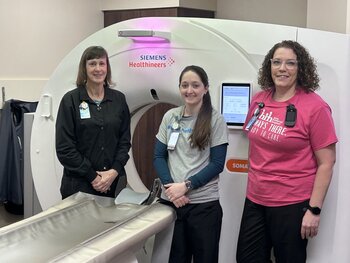
Picture of three female radiology techs, standing in front of a MRI machine.
Computed Tomography (CT)
What is it?
Computed Tomography, or CT, is a radiological method used since 1974 to create detailed images of the body—slice by slice. CT scans allow healthcare providers to see inside the body, including areas that cannot be viewed with standard X-rays.
Today, CT technology is one of the most essential tools in modern medicine, widely used for routine and emergency examinations across nearly all areas of the body.
Why CT Matters
The power of CT scanning lies in its ability to help physicians:

Diagnose diseases earlier

Visualize issues more precisely

Start treatment sooner
Since many conditions are best treated when detected early, CT scans can often save lives. At Horn Memorial Hospital, you can trust you’ll receive expert care and imaging from highly trained professionals.
CT Can Help With:

Detecting strokes, head injuries, herniated discs, and abscesses

Locating fractures quickly and accurately

Evaluating bone and soft tissue damage—especially important in trauma cases

Providing fast, initial diagnosis to guide emergency treatment

Diagnosing changes in internal organs

Examining the heart and coronary vessels

Supporting early detection of lung and intestinal cancers
What to Expect During Your CT Examination
Comfortable and Simple Process
During your CT scan, you’ll lie on a comfortable patient table (typically on your back). The table will slowly move you through the opening of the CT scanner—called the gantry.
A technologist will be present the entire time to guide you. Be sure to follow any instructions, such as when to briefly hold your breath or remain still to capture accurate images.
You won’t feel the scan itself, but you may hear a low whirring sound as the machine operates. The table may move slightly throughout the exam, but rest assured, the process is safe and gentle.
How the CT Scan is Performed
While inside the gantry, the X-ray system rotates around you to capture highly detailed cross-sectional images of your body. These images are taken in slices, allowing your doctor to view 3D, high-resolution visuals of your internal structures.
After your scan, both you and your physician will be able to review these detailed images to support your diagnosis and treatment plan.
Contrast Medium – Why and When It's Used
Depending on the type of scan, a contrast medium may be used to enhance image clarity and help strengthen the accuracy of your diagnosis.

Most patients tolerate contrast well and feel no discomfort or only mild warmth for a few moments.

The contrast medium contains iodine, which may cause an allergic reaction in some people. Important: Please inform your doctor or CT team if you have any known allergies before your appointment.

If you experience any discomfort during the scan, don’t hesitate to let the CT staff know right away. Your comfort and safety are our top priority.
How Long Does a CT Scan Take?
Scan time varies depending on the type of exam and the areas of the body being scanned. While a modern spiral CT scanner produces images within just a few seconds, you can typically expect your full exam to take 15 to 30 minutes.
If a contrast medium is required, the process may take longer. You may also need to drink a contrast solution about one hour prior to your appointment if your gastrointestinal tract needs to be coated for imaging.
What Happens After the Exam?
After your scan, a radiologist will analyze the images and send a detailed report to your physician. Your doctor will then review and discuss the results of your CT examination with you.
Digital Images = Faster Diagnosis
Horn Memorial Hospital uses the advanced Carestream DRX-1 digital radiography system, which provides instant digital X-ray images.

Within seconds of capturing an image, the system wirelessly transmits it to a digital console for immediate viewing and manipulation.

Images can be quickly forwarded to printers or shared through secure networks for collaboration.

Having images available instantly reduces exam time and allows for rapid diagnosis, especially critical in trauma cases.
For more information or to schedule:
712-364-7239
